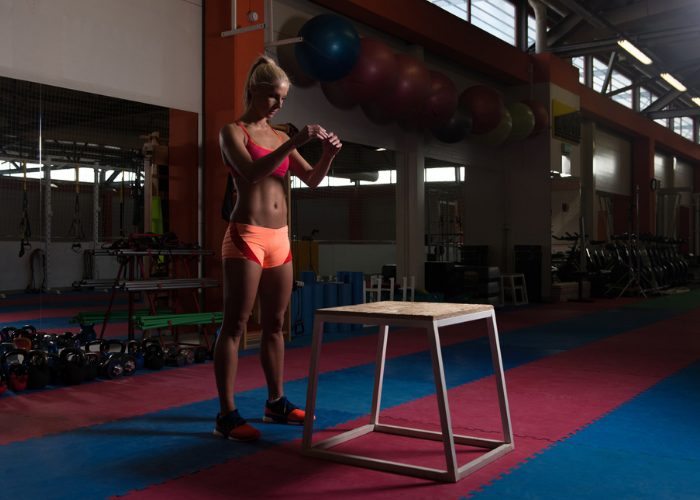Losing weight can feel like an impossible mission! If you’ve tried every technique under the sun, you may be pretty close to calling it quits. However, there’s one activity that you may have overlooked. If you’ve yet to hear about plyometric exercises, you’re in for a treat. These dynamic and explosive movements could be just what you need to get into shape and boost your fitness. Let’s take a look at the facts.
What Are Plyometric Exercises & Why Do Celebrities Love Them?

More than just a mere celebrity fad, plyometric exercises could be the secret to unlocking the next level in your fitness. Before we take a deeper look at the benefits of this activity and how to get started, you might want a simple plyometrics definition. This type of workout is sometimes called “plyos” or “jump training”. In short, the exercises require you to exert a massive amount of force in one burst.
So, what are plyometric exercises? Well, they are often jump motions, but that’s not always the case. Some of the most common exercises that this regime includes are box jumps, ice skater moves, and spider jumps. All of the above demand a high level of force from your muscles and are completed in short and sharp motions.
The workout rose to fame as it became more and more popular with celebrities. The reason that so many stars love this form of activity is that it achieves a lot in a short period. What’s more, since the moves take up a load of energy, you can be sure to burn a whole load of calories doing one of these routines.
Major Benefits of a Plyometrics Workout
Whether you’re looking to lose some weight or simply strengthen your muscles, plyometric exercises could be the way to go. In fact, there are loads of remarkable benefits that are directly associated with this particular type of training regime. Let’s take a look at some of the science-backed advantages you might find when you start out with these moves.
1. Burn body fat fast

Looking for a way to slim down and get into the best possible shape? You may just have found it. Research published in the National Institutes of Health found that combining strength training with plyometric exercises could help to burn fat.[1] After a 12-week program combining these two activities, the participants saw a significant change in their bodies. In particular, researchers found that participants’ body fat mass decreased.
What’s more, you increase the strength of your muscles which will also tone them. Try these exercises for a matter of weeks, and you should find that you gain a better, more sculpted physique!
2. Help to avoid serious training injuries

One of the most exciting benefits of taking part in plyometric exercises is that it helps to boost your flexibility. The more flexible you are, the less likely you are to hurt yourself when you’re working out. It stands to reason that as you start to improve your strength, precision, and fitness, the chances of you succumbing to injuries is unlikely.
What’s more, there’s a body of research to back-up this notion. For instance, one study from the Methodist Hospital in Houston found that learning how to jump correctly, through plyometric workouts, could help lower people’s risk of knee injury.[2] Practicing these concise exercises could be the key to fewer issues in the future.
3. Boost your strength and agility levels

Want to feel super strong and agile? One scientific review suggests taking part in 4-16 weeks of plyometric workout routines could help to improve your overall fitness immensely.[3] In particular, the researchers highlighted that these exercises improved agility and strength among participants. If you’re looking for a way to condition your body and shed some pounds as well, adopting this method of training is definitely one way you could go.
Start Plyometric Training With These 3 Moves
As we’ve already covered, research suggests that jumping plyometric exercises can help to prevent serious knee injuries in the future. However, that’s not the only reason that you should include these moves in your day-to-day plyometric training. Each movement takes a whole load of energy to complete. That means that you will burn some serious calories when you start to practice them. Let’s take a look at three to get you moving.
Box Jumps
Plyometric exercises don’t come much easier than the standard box jump. Repeating this forceful and energetic move means that you raise your heart rate while improving your lower body strength. Here’s everything you need to know about how to do it.
- Targeted muscles: Quads and core
- Repetitions: 2 sets (30 reps per set)
- Time: 5 minutes
How to do it
You will need a plyo box before you begin. Stand facing the box with your feet apart and your legs slightly bent. Crouch downward first and use that motion to push off the ground to jump upward and forward at the same time. Land on the box. Then, jump backward and land in your starting position. Repeat this action 30 times per set.
Pro Tip: There are many different sizes when it comes to plyo boxes. The one you choose will ultimately depend on your skill level. When you first get started, you will likely need quite a low box. However, as you improve, it could be worth trying the same exercise with larger (i.e. taller!) boxes instead. As always, you need to work to your own level.
Squat Jumps
Ready to get your heart racing? The chances are that you’ve seen this next jumping plyometric move before. You may have even tried it. Squat jumps are just what they say on the tin. These moves combine both squats and jumps to create one synchronized movement that packs some real power.
- Targeted muscles: Quads and core
- Repetitions: 2 sets (30 reps per set)
- Time: 5 minutes
How to do it
Start by getting down into your main squatting position. Go as low as feels comfortable for your skill level and flexibility. Next, use the power in your leg muscles to jump upward. The higher you manage to jump, the more effective this addition to your plyometric workout will be. As you land back on the ground, return to the initial squat stance. You should repeat this movement 30 times per set.
Pro Tip: Getting your form right is massively important when you’re performing these exercises. You should make sure that your legs stay strong yet limber throughout the movement. It’s also important to ensure that your chest faces upward and is straight when you’re jumping (you don’t want to bend over while doing this move!).
Depth Jumps
Depth jumps are slightly more advanced than the other jumping plyometric exercises we’ve covered here. With that in mind, it may help to spend some time focusing on the other two before you decide to finally approach these ones. The exercise will work your core while helping improve your lower body strength. Spoiler: It’s a real killer!
- Targeted muscles: Quads and core
- Repetitions: 3 sets (10 reps per set)
- Time: 4 minutes
How to do it
Start by standing on the small ploy box. Put one foot forward and drop off the box. Ideally, you should make sure that both feet land at the same time. When you’re down on the floor, quickly bend your knees and jump directly upward as high as you can.
Spend the least amount of time possible on the floor. The key is to move from box to box as swiftly and smoothly as you can. The moment your feet touch the floor, you should already be pushing upward into the jump. It will take a little practice to get this right, but you absolutely need to keep working at it.
Pro Tip: To take things up a notch, you will need two different types of plyo boxes. You should have a small one and a medium one. Line them up so that there is a gap between the two. The moment you hit the ground, jump upward onto the larger box. Follow more or less the same movement but with one small change.
You will need to use extra core strength to pull this off properly. When you get it right, though, it will really pay off. You can then return to the original box or simply turn around to repeat the same action once more.
The 10 Best Beginner Plyometric Exercises for Weight Loss
Wondering how to design the ultimate plyometric workout routine to burn some fat? You’ve come to the right place. The awesome thing about these types of moves is that they require you to put in some real force, so you may notice after a while you start to lose weight. You’ll also be giving your muscles an effective workout session too. Combine those two things and you can be certain that plyometric exercises will help you lose weight. Here are ten moves to try!
1. Leg Bounding
Bounding is one of the staples of any plyometric workout, and for good reason. This type of movement helps to increase your coordination levels while also giving our muscles a deep, strengthening workout. It’s energetic and fast-paced. You might even say that it’s one of the most explosive exercises you can do, combining a swift movement with a quick blast of energy at the same time. Here’s how you can try it for yourself.
- Targeted muscles: Quads and core
- Repetitions: 2 sets (20 reps per set)
- Time: 4 minutes
How to do it
First of all, you will need to start in a jogging position. As one foot lands, you should give a quick blast of energy to push your entire body forward. Move the opposing leg into a 90-degree angle as you do so. You should bound forward and gain some height. Alternate between your legs and make sure that you use your core strength to guide you here. When you’re moving, your arms should move forward with you.
Pro Tip: The further forward you move, the better these plyometric exercises will ultimately work. At first, you might find it hard to move too far forward. Don’t worry. As you gain in power, you will find that you naturally cover more distance during this particular plyometric workout.
2. Forward Box Shuffle
Creating your own box jump workout? The forward box shuffle is one of the best plyometric exercises you can learn. What’s more, it’s strikingly simple. Before you get started with this particular exercise, you will need a fitness plyo box. Perhaps your local gym will have one. Keep in mind that there are different sizes when it comes to boxes. You should start off with a small (i.e. short box) before moving onto larger ones as you progress.
- Targeted muscles: Quads, glutes, and core
- Repetitions: 3 sets (20 reps per set)
- Time: 5 minutes
How to do it
Start by standing directly parallel to the box itself with your feet a hip-width apart. In a fluid motion, jump upward and move one foot forward to hit the top of the box. As you move down, chance legs in a shuffling motion. You will need to alternate legs and ensure that you maintain your balance and precision throughout this particular exercise. Simple.
Pro Tip: Don’t panic when it comes to your speed! Plyometric exercises are not the same as HIIT workouts. You need to take them slow and steady when you first get started. You will find that being concise gets you a long way when it comes to the box shuffle. Take your time and make sure that you focus on each movement.
3. Plyo Push-ups
You may already include a basic push-up as part of your fitness routine. However, to turn this staple into a set of plyometric exercises, you’re going to need to alter the way you do them. As one of the most effective upper body plyometric exercises, you should find that this one is simple to approach and straightforward. Here’s how to get it right straight away.
- Targeted muscles: Biceps, triceps, and core
- Repetitions: 2 sets (20 reps per set)
- Time: 4 minutes
How to do it
Being in the starting push-up position. Your hands should be directly below your shoulders and your back should not be arched. Ease your body downward by bending your arms at the elbows and carrying your weight. When you reach the bottom of the push-up, it’s time to turn this into an explosive exercise.
Then, push upward with a strong burst of energy so that your hands lift up from the ground. You will want to start with small jumps when you first begin, but as you progress, you can lift yourself higher and higher. Return to the starting position and repeat this exercise again.
Pro Tip: When you’ve mastered the basics of these plyometric exercises, it’s time to take things to an entirely new level. To kick things up a notch, why not add a clap into the mix? This takes extra skill so don’t rush ahead to do it until you’re ready. As you lift yourself off the ground during the plyo push-up, clap your hands together quickly before you land.
4. Alternating Plyo Lunges
When you first start explosive training, you may wonder where to start. Getting your lower body fix needn’t be hard. It’s simply about adapting some of the exercises with which you’re already familiar and making them work for you. One example of this is the alternating plyo lunges. You take the basic lunge exercise (which you may well already include in your training) and give it an explosive, energetic twist.
- Targeted muscles: Quads and core
- Repetitions: 2 sets (30 reps per set)
- Time: 5 minutes
How to do it
Start with your feet a hip-width apart and your core tucked in. Keep it tight. Next, take one leg and lunge forward. Rather than simply easing into this position, you should jump forward into it. When you’re down in the lunge position, use as much energy as you can to jump back up and alternate legs. The idea is to get your muscles working and push as hard as you can off the floor with each jump.
Pro Tip: When you first get started, you might find that it’s quite difficult to jump and alternate in mid-air. Should you have that problem, there’s a super simple solution you can give a whirl. Rather than alternating, focus on one leg at a time. Try a set of 30 lunge jumps with your left leg bent and then switch to do the same on your right leg.
5. Spider Lunges
As scary as these plyometric exercises may sound, they are frightfully easy to get right. The spider lunges work the lower half of your body while focusing on your core strength at the same time. You can do these activities wherever and whenever you please.
- Targeted muscles: Quads and core
- Repetitions: 3 sets (12 reps per set)
- Time: 3 minutes
How to do it
To start, you should get down into high-plank position. Your arms need to be directly below your shoulders and your back should be kept as flat as possible. Bring one of your legs forward and out to the side at the same time. Your foot should be just behind the corresponding arm when you do this. Then, switch sides and alternate this activity. You need to do 12 repetitions per set. And… go!
Pro Tip: At first, you might find that this particular exercise is a little hard to master. As you move forward in your plyometric training, though, you will find that you can do it with your eyes closed. Once you reach that level, be sure to take things to a new difficulty range. You can speed up this activity to get your sweat on as you work out.
6. Plyo Jack
Jumping jacks are pretty standard in most aerobic workouts so you might find yourself wondering what they have to do with your plyometric workout. Adjusting the way in which you jump and increasing the intensity here means that you will get an entirely new experience. It’s all about putting extra pressure on your muscles and making sure that they work to their full potential as you move.
- Targeted muscles: Quads and core
- Repetitions: 4 sets (10 reps per set)
- Time: 4 minutes
How to do it
Rather than starting in a standard jack position, you need to begin in a closed-leg squat position. Use that tension to really fuel your plyometric exercises. Then, with as much energy as you can muster, jump upward and propel yourself into the air. As you do so, stretch your arms and legs outward into the jack position. When you land, you need to come back into the original squatting position once again.
Pro Tip: Power is everything when it comes to this type of plyometric training. The more you practice this activity, the easier it will become to get some real force behind each jump. As you move upward, your muscles have to work extra hard to hoist your weight. This activity boosts your fitness level while strengthening some key muscle groups too.
7. Squat Thrusters
And now, for one of the best plyometric exercises out there. Squat thrusters are just about as exciting as they sound. These are similar to burpees (we will look at those in a moment!) only you start in a different position. They require a serious burst of energy along with a whole lot of skill. This type of plyometric training works the lower half of your body along with your core but it also helps to raise your heart rate. That’s great for weight loss! Here’s how you can get started and do some squat thrusters for yourself.
- Targeted muscles: Quads and core
- Repetitions: 3 sets (10 reps per set)
- Time: 3 minutes
How to do it
Start in the high-plank position. Make sure that you have a strong core and can maintain your balance at all times. In one jumping motion, bring both your legs upward and forward so that you are in crouch position. When you’ve done that, you need to jump backward to return to your original position. Try to repeat this action 10 times per set. Remember, your movements should be explosive and concise at all times.
Pro Tip: Ready to add to your current plyometric workout routine? Why not mix up this exercise and include a little more movement in there too. Each time you complete a set, change the position of your plank. Get up, move around, and then get back into the plank position. Doing so will help to vary the activity and raise your heart rate even more.
8. Tuck Jumps
If you’ve ever taken part in any athletic sports training, you may already be comfortable with these plyometric exercises. As far as jumping exercises go, you will struggle to find many that are more effective than these. As soon as you have managed to master this move, you can start to include it in your frequent plyometric workout routines. Here’s how you can get it right and make the activity work for your skill level.
- Targeted muscles: Quads and core
- Repetitions: 3 sets (15 reps per set)
- Time: 4 minutes
How to do it
Precision and form are crucial when it comes to these plyometric exercises. Begin with your feet a hip-width apart and bend your knees slightly. In one swift movement, jump upward as high as you can. When you’re in mid-air, you should bring your knees upward to a 90-degree angle (it will look as though you’re sitting on an invisible chair). Bring your arms down as you do so. Finally, be sure to land with your knees in a soft position and your feet at the same width again.
Pro Tip: Finding it hard to get a grip on these plyometric exercises? The reason could be relatively obvious. If you’re failing to jump high enough, you could find that you don’t have the time to complete a full tuck. Don’t make that mistake. Increase the energy when you first jump upward so that you get a good distance off the ground with each movement.
9. Burpees with Tuck Jumps
Perhaps some of the best plyometric exercises for weight loss combine two different movements as one activity. The burpees with a tuck jump move is the ideal example of just that. If you are at all familiar with either of these exercises (see above for tuck jumps), you will find that learning this swift exercise doesn’t take too much effort at all.
- Targeted muscles: Quads, biceps, triceps, and core
- Repetitions: 3 sets (10 reps per set)
- Time: 3 minutes
How to do it
Start by standing in a limber position, with your knees bent. Jump both of your legs backward and move forward onto your hands so that you’re in plank position. Next, jump your legs forward so that you reach crouch position.
From there, you will need to jump upward and tuck your legs forward as you do so. When you land, you are back in the starting position. These actions should come seamlessly after one another to create a fluid motion. Repeat the exercise 10 times per set.
Pro Tip: Finding this activity seriously difficult? Okay, we’ll admit that it’s a little harder than it looks. If you’d rather make it a little easier on yourself, there’s a second option that you might want to try instead. Rather than including the tuck jump, just do the burpees. Make sure that you add extra energy to your workout to make these truly explosive exercises.
10. Ice Skaters
You won’t need to wear a pair of ice skates to complete ice skater. You can complete this move in any gym or in your home. Moving quickly from side to side helps to boost your agility while the quick-change motion will help to improve your balance. Here’s what you need to know about getting started.
- Targeted muscles: Quads and core
- Repetitions: 3 sets (20 reps per set)
- Time: 5 minutes
How to do it
Start with your legs a hip-width apart and lean forward. Keep your back as straight as possible. Jump to the right side and bring your left leg swiftly behind your right. Next, jump to the left and repeat the same action with your right leg. These plyometric exercises get their name because, when you get them right, it will look like you’re ice skating. When you have mastered the basic technique, you will need to string it all together in a fast and fluid motion. Unlike some plyometric exercises, these should be done as fast as possible.
Pro Tip: Get down low! When you’re doing ice skater plyometric exercises, one of the most important rules is to bend down low. It may help to put your arms out in front of you and to move them in unison as you move the rest of your body. Doing so will mean that these particular plyometric exercises will be more effective.
Tips to Ace Your Next Workout
You know all about the best plyometric moves already. So, how can you get started? Before you don your fitness gear and head to the gym, there are just a few things that you likely need to know. Here are some quick and easy tips to help you along the way.
1. Warm up well before your plyometric training
Needless to say, plyometric exercises put a whole load of strain on your muscles and your body in general. You need to be flexible and agile to pull each move off. Before you get started, you should always warm up. Doing so could help you to avoid any serious injuries while also ensuring that you boost your flexibility.[4]
During your warm-up session, you will increase the blood flow in your body. That means that each of your muscles gets more oxygen. It also improves your range of motion. So, when you start doing the plyometric exercises, your body is fully prepared for the moves.
2. Avoid over-training when you first start
If you’re completely new to the world of plyometric exercises, it’s only natural that the idea of these workouts will excite you. However, the last thing you want to do is over-train. You need to make sure that you allow for proper recovery between sessions. (That means that you absolutely should not be engaging in these exercises each and every day!) Doing so could lead to exhaustion and physical fatigue, which are two problems you want to avoid.
3. Don’t be afraid to ask for support
We know – these exercises can be difficult. If you’ve never done a plyometric workout before now, the chances are that you will find it quite hard. Since these moves are all about being as precise as possible, it may help to ask a trainer or professional for some advice. When you’re unsure of how to execute any given plyometric move, go ahead and ask someone. Failing to do so means that you could end up injuring yourself.

Conclusion
Adding some plyometric exercises to your routine is not a big ask and could make a serious difference to your fitness levels. There are plenty of benefits when it comes to these types of movements, which is why they have grown in popularity in recent years. Why not give them a go today? Follow our helpful guide and get started now.
References
- [1] https://www.ncbi.nlm.nih.gov/pmc/articles/PMC4120445
- [2] https://www.newswise.com/articles/go-ahead-and-jump-learning-how-to-properly-jump-and-land-can-help-female-athletes-avoid-serious-knee-injuries
- [3] https://www.ncbi.nlm.nih.gov/pmc/articles/PMC5260592
- [4] https://www.nhsinform.scot/healthy-living/keeping-active/before-and-after-exercise/warm-up-and-cool-down








